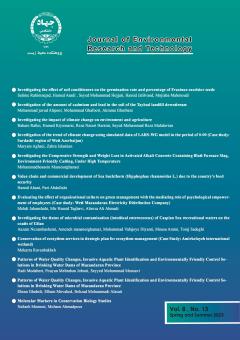-
-
-
Open Access Article
1 - Evaluation of forest road characteristics and comparison with environmental and technical standards (Case study: Tang-e-Sulk Bahmii Protected Area, South Zagros)
Seyed Ata ollah HosseiniThe aim of the study is to compare road geometric characteristics with standard road construction values. The study area is Tang-e-Sulak, protected area located in Bahmiy (Kohgiluyeh and Boyerahmad), at the southern Zagros forests. First, the existing road location was MoreThe aim of the study is to compare road geometric characteristics with standard road construction values. The study area is Tang-e-Sulak, protected area located in Bahmiy (Kohgiluyeh and Boyerahmad), at the southern Zagros forests. First, the existing road location was taken using GPS and then placed on a topographic map. In the next step, the slopes were graded (from 0-10, 10-20, 20-30, 30-40, 40-50, 50-60 and > 60 percent), then 11 samples were randomly selected on each slope. In the next step, the size of the samples was compared with the standard values (Booklet No. 131 and 161). The width of the running surface and path of the way were analyzed on the basis of analytical and other road geometric characteristics based on descriptive statistics. Soil samples were taken from each of the slopes’ grades. Data analysis was done by T-test and Pearson correlation in SPSS 22. The results show that the width of the road and the construction area of the road on the slopes 10-20, 40-50, 60-50, and 60 were less than the standard values and it is statistically significance (P<0.01), and in other slopes wasn’t significant differences. Analytical descriptive statistics showed that the average slope of excavation and embankment walls is 15% higher than the standard value. The results of soil texture analysis by unified classification method showed silty- clay texture.Analytical descriptive statistics showed that the average slope of excavation and embankment walls is 15% higher than the standard value.The results of soil texture showed siltyclay texture. Manuscript profile -
Open Access Article
2 - Investigation of Diameter and Height Growth of Willow and Alder in Road Fill-Slope Landslide Bioengineering Stabilization (Surdar-Watashan District Chamestan, Mazandaran)
Seyed Ata ollah HosseiniThe aim of this study was to evaluate the diameter and height growth of two native species of alder (Alnus glutinosa L. Gaertn.) and willow (Salix alba L.) planted in three treatments including natural mulches of straw, wood chips and bare soil without mulch (as control MoreThe aim of this study was to evaluate the diameter and height growth of two native species of alder (Alnus glutinosa L. Gaertn.) and willow (Salix alba L.) planted in three treatments including natural mulches of straw, wood chips and bare soil without mulch (as control) treatments. The design of the experiments was in the form of split plots and in the form of completely random blocks located in Chamestan, Mazandaran. The results showed that the regression relationships between diameter and height in alder species were better than those of willow species completely randomly. The study area was in parcels 5 of series 3 district of Surdar -Watashan forestry plan in watershed 49 of forests in the north of the country. The regression coefficient for the independent variable of diameter and dependent variable of height was 0.65 in alder and 0.42 in willow. The results showed that the regression relationship between diameter and height in alder was better than willow species. According to the results of variance analysis, the blocks and treatments did not have a statistically significant difference. The wood chips treatment created the best situation, and after that, the straw treatment and finally the control treatment (bare soil) had a more unfavorable situation than the other treatments. Finally, alder had more favorable conditions for adaptation to the applied bioengineering conditions of the present study vs. willow. Manuscript profile
List of Articles Seyed Ata ollah Hosseini
-
The rights to this website are owned by the Raimag Press Management System.
Copyright © 2017-2024


